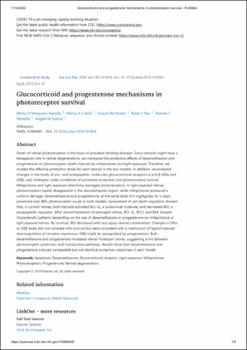| dc.description.abstract | Abstract
Death of retinal photoreceptors is the basis of prevalent blinding diseases. Since steroids might have a therapeutic role in retinal degenerations, we compared the protective effects of dexamethasone and progesterone on photoreceptor death induced by mifepristone and light exposure. Therefore, we studied the effective protection doses for each steroid in the two models. In addition, we analyzed changes in the levels of pro- and antiapoptotic molecules, glucocorticoid receptors α and β (GRα and GRβ), and rhodopsin under conditions of successful protection and photoreceptor survival. Mifepristone and light exposure selectively damaged photoreceptors. In light exposed retinas, photoreceptors mainly disappeared in the dorsotemporal region, while mifepristone produced a uniform damage. Dexamethasone and progesterone, at the same dose of 4 mg/kg/day for 2 days, preserved over 88% photoreceptor nuclei in both models. Assessment of cell death regulators showed that, in control retinas, both steroids activated BCL-XL, a prosurvival molecule, and decreased BID, a proapoptotic regulator. After steroid treatment of damaged retinas, BCL-XL, BCL2 and BAX showed characteristic patterns depending on the use of dexamethasone or progesterone on mifepristone or light exposed retinas. By contrast, BID decreased with any injury-steroid combination. Changes in GRα or GRβ levels did not correlate with survival but were consistent with a mechanism of ligand induced downregulation of receptor expression. GRβ might be upregulated by progesterone. Both dexamethasone and progesterone increased retinal rhodopsin stores, suggesting a link between photoreceptor protection and transduction pathways. Results show that dexamethasone and progesterone induced comparable but not identical protection responses in each model. | en_US |


